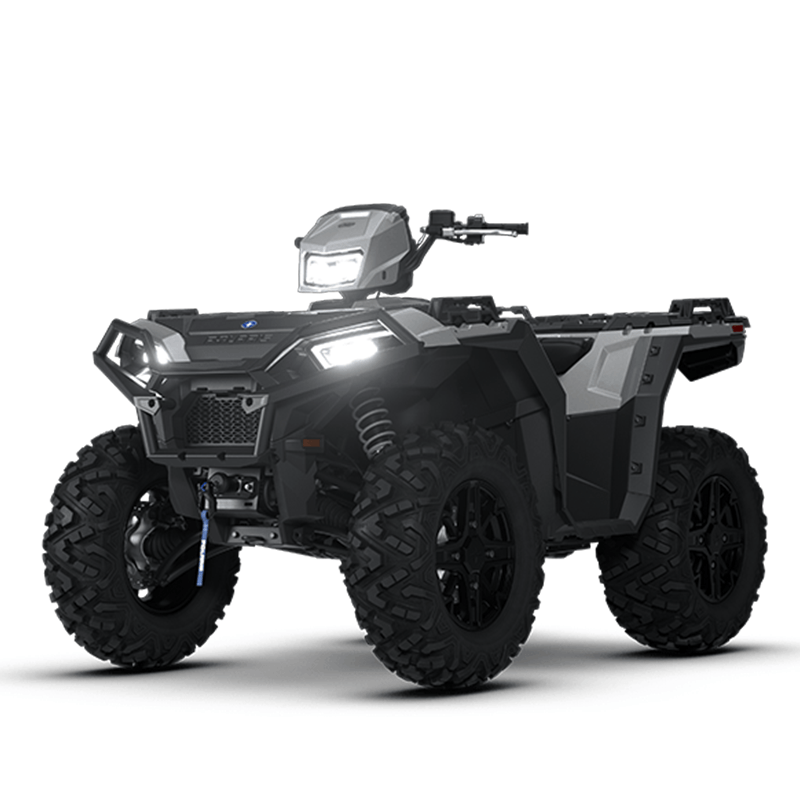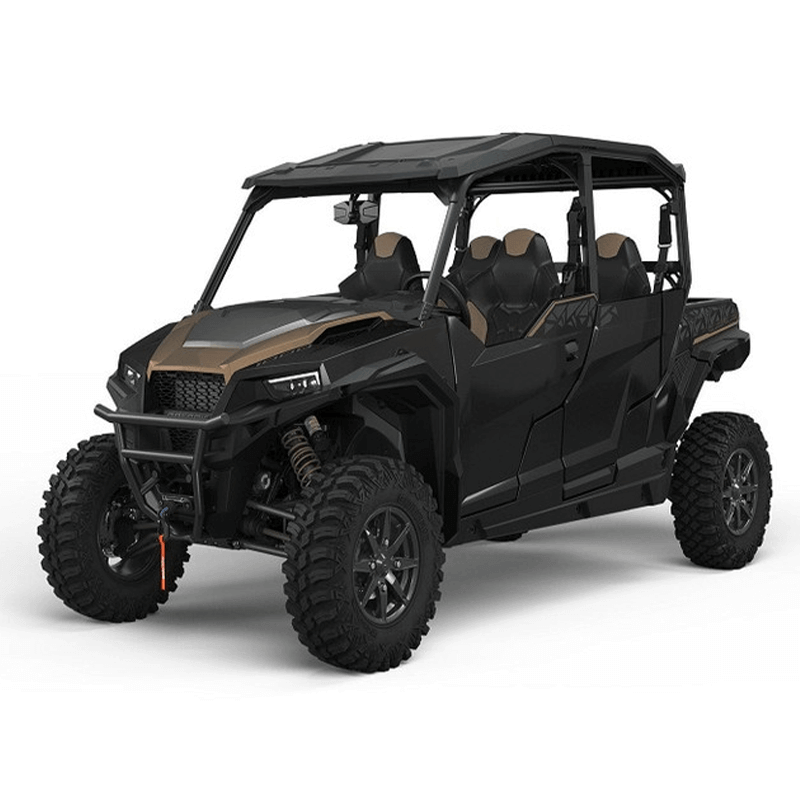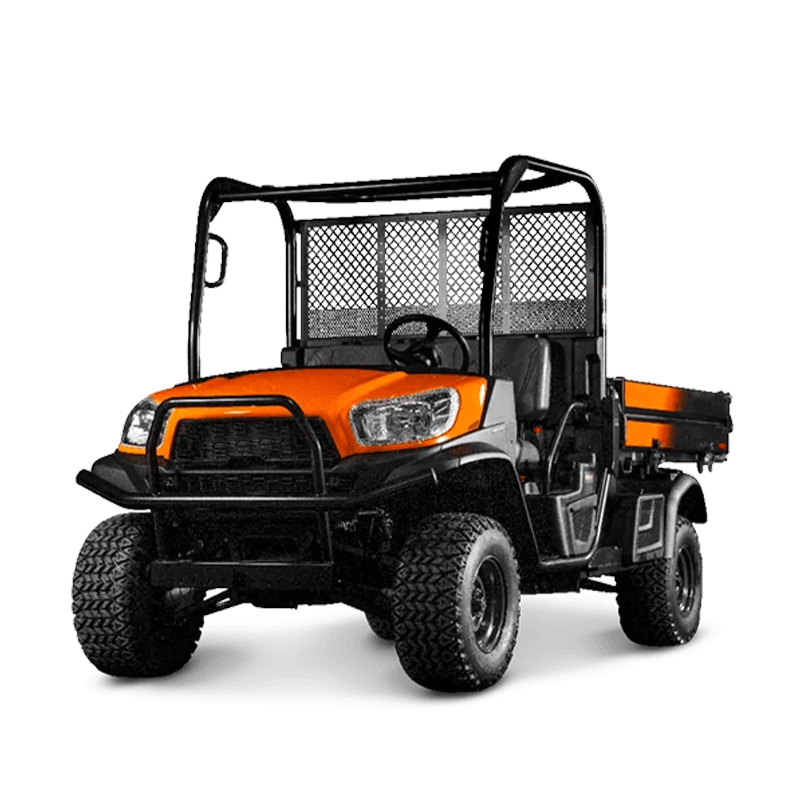Did you ever wonder why there are three different off-road vehicles, RTV Vs. UTV Vs. ATV, and why do they sound so similar? So what’s the difference?
This guide will walk you through detailedly what they are and tell you their differences through a clear table, from key differences in design, use, to performance, helping you choose the right off-road vehicles.
What is an ATV?
An ATV, or All-Terrain Vehicle, is what most people picture when they think of a “quad” or “four-wheeler.” It is designed around a single-rider philosophy, prioritizing agility and a direct connection to the trail.
The operator sits on a motorcycle-style straddle seat and uses handlebars to steer. This requires an active riding style where the rider shifts their body weight to maintain stability, making for an engaging and physically demanding experience. Because they are smaller, lighter, and more nimble, ATVs are the undisputed kings of recreational sport riding and navigating tight, winding trails where larger vehicles can’t go.


What is a UTV?
A UTV, or Utility Task Vehicle, represents a complete shift in design. Commonly called a Side-by-Side (SXS), its core feature is its car-like design, seating occupants next to each other in bucket or bench seats.
UTVs are manipulated through the steering wheel together with foot pedals, making the handling feel familiar, more on the passive side, and requiring not much bodily toil. Their foundation frame is constructed larger and steadier, so safety is much exceeding ATV, since already inborn they already have a roll-over protection system and safety belts. The chief merit lies in versatility: able to seat from two to six persons, with one cargo bed set behind. Therefore, UTV can serve both for toil—such as carrying tools on farmland, delivering manpower on a construction site—and also for amusement, like weekend loading of gear to go adventuring, all can be managed.
What is an RTV?
This is where the confusion often begins. An RTV, or Rough Terrain Vehicle, is not a separate vehicle category. RTV is the trademarked name Kubota uses for its line of UTVs.
So, why the different name? Because Kubota builds its RTVs with a distinct, work-first philosophy that sets them apart. While other brands offer UTVs that blur the line between work and play, a Kubota RTV is an unapologetic workhorse. Its design DNA comes from tractors and construction equipment, not recreational toys. As one user on a forum aptly put it, they are “built like a tank.”

Key features that define an RTV include:
- Industrial-Grade Diesel Engines: Most RTVs use Kubota’s own heavy-duty diesel engines, prized for immense low-end torque, durability, and better fuel economy, not for high top speeds.
- Variable Hydrostatic Transmission (VHT): This is the RTV’s secret weapon. Instead of a belt-driven CVT, a VHT uses fluid pressure to transmit power. This means no belts to slip or break under heavy load, incredibly smooth acceleration, and powerful dynamic braking for unmatched control on steep descents.
- Tractor-Like Durability: From all-steel cargo beds with hydraulic dumps to a robust frame, an RTV is built to withstand daily abuse. It looks and feels less like a golf cart and more like a miniature truck.
RTV Vs. UTV Vs. ATV: What’s the Difference?
| Feature | ATV | UTV | RTV |
|---|---|---|---|
| Identity | Single-rider sport quad | Multi-purpose side-by-side | Kubota’s heavy-duty work UTV |
| Primary Focus | Recreation & Speed | Versatility (Work & Play) | Purely Work & Hauling |
| Operation | Straddle seat, Handlebars | Side-by-side seats, Steering Wheel | Side-by-side seats, Steering Wheel |
| Key Strength | Agility & Low Cost | Safety & Passenger Capacity | Extreme Durability & Torque |
Design Philosophy and Primary Use
ATV: The Agile Athlete
An ATV is for sport and recreation. Its main purpose is to be a fun, fast, and nimble machine, often upgraded with ATV racing parts to push its performance limits on the track and trail. It excels in tight, technical terrain where its small size and responsiveness are paramount.
UTV: The Versatile All-Rounder
A UTV is the jack-of-all-trades. It is designed to bridge the gap between work and play, capable of hauling supplies during the week and exploring trails with family or friends on the weekend. Its identity is split between utility and recreation.
RTV: The Uncompromising Workhorse
An RTV’s purpose is singular: to reliably perform work. Whether hauling feed on a farm or tools on a construction site, its design prioritizes durability, pulling power, and dependability over all else. Speed and recreation are secondary considerations.
Operation and Seating
- ATV: Features a motorcycle-style straddle seat and handlebar steering. This is physically engaging and primarily for one person.
- UTV & RTV: Both use a car-style layout with a steering wheel, pedals, and side-by-side seating for two to six people, offering a more comfortable and less demanding ride.
Performance and Powertrain
- ATV: ATV: Engines are designed for high RPMs and speed. Keeping them light and quick requires top-condition components, and sourcing quality ATV engine parts is crucial for maintaining that peak performance.
- UTV: Typically uses a gasoline engine with a belt-driven CVT (Continuously Variable Transmission) to offer a balance of speed and utility. High-performance models can be extremely fast.
- RTV: Primarily relies on high-torque diesel engines and a beltless Variable Hydrostatic Transmission (VHT). This system excels at delivering pulling power and durability, though top speed is generally limited to around 25-40 mph (40-65 kph).
Safety and Capacity
- ATV: Offers minimal built-in safety features. There is no roll cage or seatbelt. Its hauling capacity is limited, typically around 250 pounds.
- UTV & RTV: Both are significantly safer due to their standard roll-over protection systems and seatbelts. They have substantial payload and towing capacities. Utility UTVs and RTVs can have payload capacities over 1,100 lbs and towing ratings up to 2,500 lbs.
Cost of Buying and Ownership
- ATV: Generally, the most affordable option, with average prices ranging from $15,000 to $20,000 for top-spec models.
- UTV & RTV: The more costly it becomes, for the reason of its dimensions and the functions inside. The model of utility, which is top-spec, often the price stays between eighteen thousand and twenty-eight thousand. The RTV using diesel often can give thirty to forty percent more good fuel economy than the gasoline UTV, so in the long run, it maybe will causing the cost of running to go down.
RTV Vs. UTV Vs. ATV: Choose For Your Needs
Ultimately, which one you should choose depends on your needs. You can choose ATV for recreation, choose UTV for balancing family fun and utility, and choose RTV for heavy-duty work.
No matter which vehicle you choose, keeping it in top condition is key to protecting your investment. This is where FridayParts comes in as your trusted partner. We offer a vast selection of high-quality aftermarket parts for your ATV, UTV, or RTV. Keep your machine running strong for years to come with our reliable and durable components. And for winter maintenance, you can also read: How to Winterize an ATV and a UTV?
